WILLIAM GILL is an offshoot of Arkengarthdale in the northern Pennines and is the shallow valley leading to the source of Arkle Beck. It???s a place only the lonely visit because it???s right in the middle of one of those vast empty boglands which fester unobtrusively among the high moors. Crossing William Gill a couple of months ago, on a walk to Tan Hill, I spotted what appeared to be a single length of railway line poking mournfully into the sky on the crown of the moor. Subsequent research has cast a guttering light on something that might be vaguely interesting. Boots on, here we go . . .
William Gill is a strange name for a topographical feature. Did you know there have been three famous Manxmen called William Gill? No, I didn???t either. William Gill is also the name of a British explorer, an American boxer, a Canadian artist and a 19th Century photographer from Colchester.
This William Gill ??? our William Gill ??? wiggles pleasantly from the old Tan Hill turnpike road south-west through Arkengarthdale Moor towards Stonesdale Moor. Unlike its human namesakes it is famous for nothing, and outside grouse-shooting circles it remains unknown, unloved and bereft of praise.

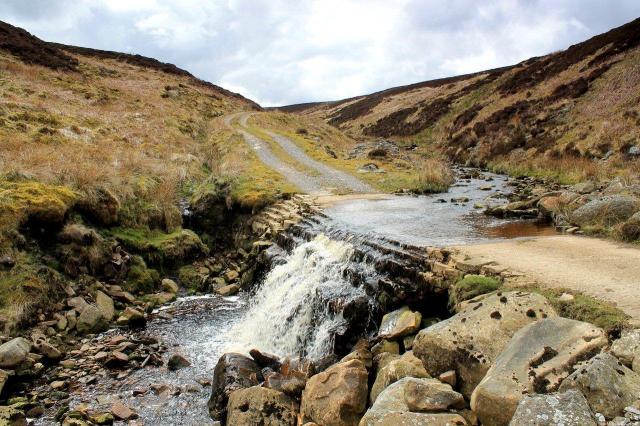
 I have decided to venture into its depths because, according to the 1851 census, seven men lived in this inhospitable place. They were colliers ??? coal miners, pit fellas. And their place of work was William Gill Colliery, one of the many shallow pits dotting these moors.
I have decided to venture into its depths because, according to the 1851 census, seven men lived in this inhospitable place. They were colliers ??? coal miners, pit fellas. And their place of work was William Gill Colliery, one of the many shallow pits dotting these moors.
Please don???t be misled by the word ???colliery???. It conjures up all sorts of images from flat caps, mufflers and whippets to towering headframes, steam shunters and picket lines. These moorland collieries were shallow scrapings which had changed little since mediaeval times. They were powered by horses and the coal was won by hardy men who died young. These were small pits in wild places ??? shallow pits drenched with bog-water and producing poor, shaly coal. They were worked from the 13th Century through to the early 20th Century ??? and they have virtually disappeared from the face of the earth.
 I spend a pleasant hour or so wandering up a dirt road that follows Arkle Beck into William Gill. Evidence of grouse shooting is everywhere ??? lines of butts; spent cartridges; old tracks widened by mechanical diggers in a particularly unsympathetic manner in order to increase profit yields, and this in a national park where the public are encouraged to respect the environment. Still, the guns are silent today and I have the place to myself.
I spend a pleasant hour or so wandering up a dirt road that follows Arkle Beck into William Gill. Evidence of grouse shooting is everywhere ??? lines of butts; spent cartridges; old tracks widened by mechanical diggers in a particularly unsympathetic manner in order to increase profit yields, and this in a national park where the public are encouraged to respect the environment. Still, the guns are silent today and I have the place to myself.
 At the very top of the gill, beyond the end of the ugliest track, I spy the railway line poking into the sky. I???m expecting to make a discovery up here. I???ve been examining satellite images on the Bing Maps website and have spotted what appears to be the remains of a horse whim.
At the very top of the gill, beyond the end of the ugliest track, I spy the railway line poking into the sky. I???m expecting to make a discovery up here. I???ve been examining satellite images on the Bing Maps website and have spotted what appears to be the remains of a horse whim.
Horse whim? Come on, keep up. We???ve visited horse whims before, but this one promises to be the best example yet. A horse whim was a capstan powered by a horse. The horse walked round in a circle, turning the capstan, and the capstan hauled kibbles (rounded buckets) of coal or other minerals from the depths of a vertical shaft.
Shafts powered by horse whims were also known as gin pits (gin being a corruption of engine), whim pits, windy pits (windy from winding) and horse-winding pits. They were largely superseded by stationary steam engines but survived in remote and less-prosperous mining areas into the late 19th Century.
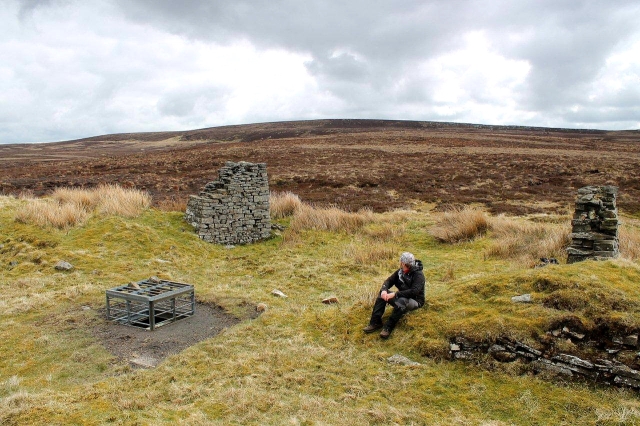
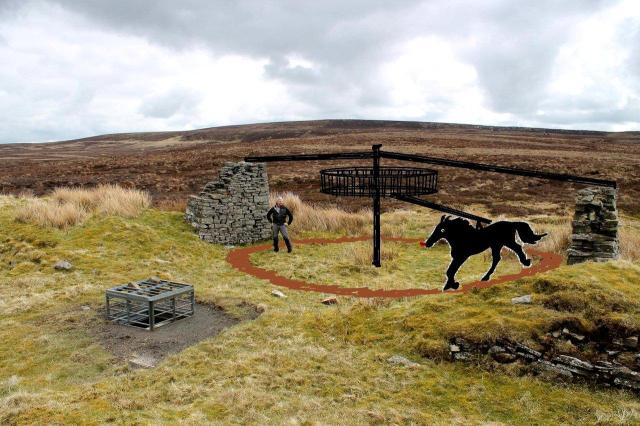
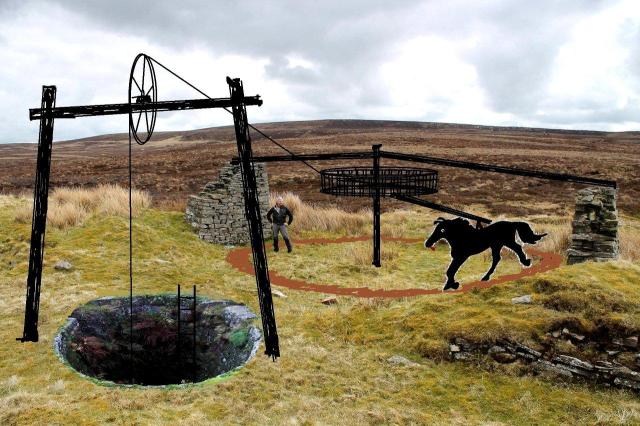 So I clamber up the side of a heathery spoil heap and find my horse whim. Glimpsed from space, this one. How cool is that? Boldly going, I stumble upon the main colliery shaft right on the edge of the horse whim circle. It has been capped off with metal sheets and bars for safety purposes, but otherwise it???s in fine condition ??? a circular, stone-lined shaft about two metres in diameter and plunging down into a scary darkness where the sound of dripping water echoes chillingly.
So I clamber up the side of a heathery spoil heap and find my horse whim. Glimpsed from space, this one. How cool is that? Boldly going, I stumble upon the main colliery shaft right on the edge of the horse whim circle. It has been capped off with metal sheets and bars for safety purposes, but otherwise it???s in fine condition ??? a circular, stone-lined shaft about two metres in diameter and plunging down into a scary darkness where the sound of dripping water echoes chillingly.
I do what everyone does when confronted by a deep and dangerous hole and lob a stone in. The stone falls for three seconds before slapping into water. How deep is that? Twenty metres, thirty metres? And how deep is the water at the bottom? Questions that remain unanswered.

Someone has tried and failed (not me, I add) to lob these great rocks down the shaft. Good job there was a grille on top or they might have ended up down there themselves
 But it???s the horse whim I???ve climbed up here to see, and this really is the most complete example I have chanced upon in the northern Pennines. The two retaining walls that held the capstan cross-beams are still standing and the circular layout of the structure can be clearly observed. Everything else has vanished ??? but nothing lasts for long in this extremely harsh environment.
But it???s the horse whim I???ve climbed up here to see, and this really is the most complete example I have chanced upon in the northern Pennines. The two retaining walls that held the capstan cross-beams are still standing and the circular layout of the structure can be clearly observed. Everything else has vanished ??? but nothing lasts for long in this extremely harsh environment.


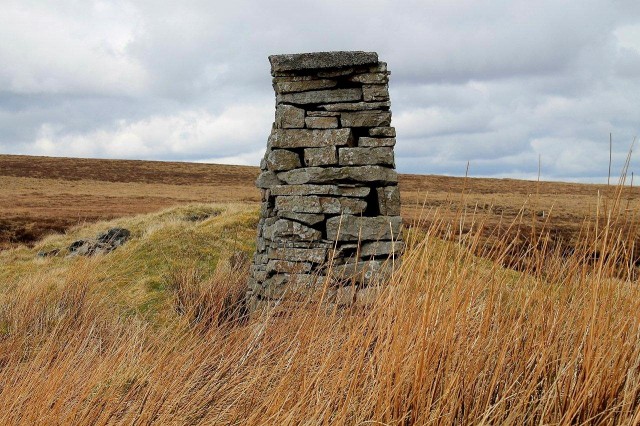
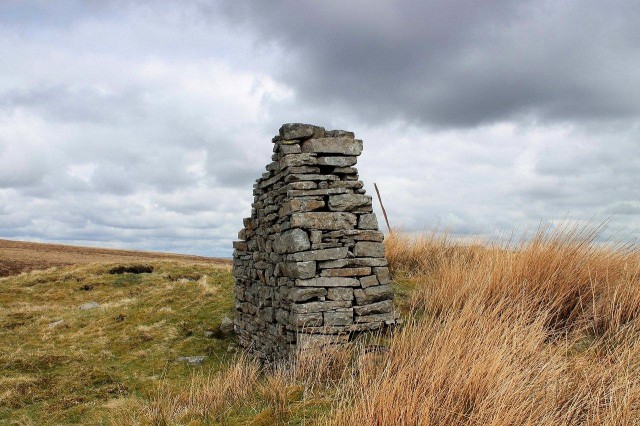 From what I can glean, William Gill Colliery was worked from 1779 to 1893. Records are scant, but according to the Durham Mining Museum website the owner and manager during its final years was one Joseph Caygill. He was preceded by William Caygill. That???s about it. Dead end for now.
From what I can glean, William Gill Colliery was worked from 1779 to 1893. Records are scant, but according to the Durham Mining Museum website the owner and manager during its final years was one Joseph Caygill. He was preceded by William Caygill. That???s about it. Dead end for now.
I find stuff like this fascinating. People lived and worked up here for more than a hundred years, yet nearly all trace of their lives and labours has disappeared from written record ??? if it ever existed in the first place ??? or been swallowed by hungry moors. What was once a scene of grimy and impoverished industry, where men slept in turf-roof hovels and spent their waking hours in filth and darkness, is now the preserve of the bird-shooting wealthy with their Range Rover Sports and expensive guns. How did that happen?
All that???s left up here are two walls, a hole in the ground, and a length of iron rail pointing somewhat poignantly towards heaven. History marches on and in doing so has almost wiped the slate clean.
 I take my leave of William Gill Colliery and tramp across the moor to Lad Gill, passing some flooded trial shafts which lurk like black holes in the heather. At Lad Gill is another tiny colliery, this one possessing a ruined workshop, or bothy, and a fine heap of slack stretching across the moor. There???s a word you don???t hear nowadays ??? slack, as in coal slack.
I take my leave of William Gill Colliery and tramp across the moor to Lad Gill, passing some flooded trial shafts which lurk like black holes in the heather. At Lad Gill is another tiny colliery, this one possessing a ruined workshop, or bothy, and a fine heap of slack stretching across the moor. There???s a word you don???t hear nowadays ??? slack, as in coal slack.


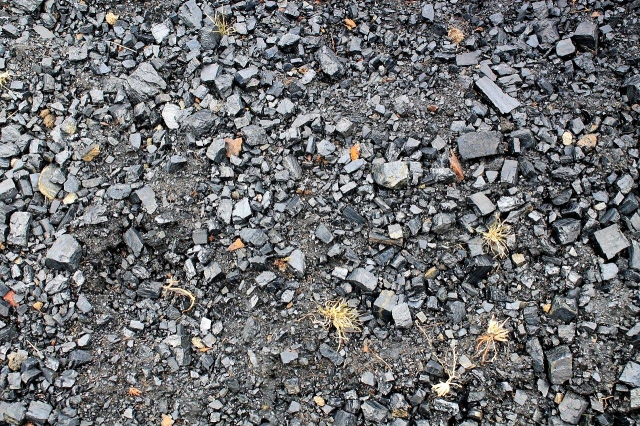
 I tramp pensively down William Gill to the van. Days like this always end the same way. They begin with hope and expectancy, climax in wonder and sometimes euphoria, then sink into a dismal sullenness on the road home as history drags at my heels like a wet sack.
I tramp pensively down William Gill to the van. Days like this always end the same way. They begin with hope and expectancy, climax in wonder and sometimes euphoria, then sink into a dismal sullenness on the road home as history drags at my heels like a wet sack.
It???s the futility of past lives that gets to me. The prospect of the ceaseless grind in order to earn a few pennies to keep starvation from the door. The horror ??? horror by our standards, anyway ??? of living in draughty, damp, depressing hovels and spending your working life immersed in filth and darkness with nothing to show at the end except a few spidery words in a parish register. God, that???s depressing. And once so commonplace.
So I amuse myself with mental probings into the origins of the word ???slack???, and how that once-famous parody of an old music-hall song ??? quoted with hilarity by older generations ??? would probably prompt little more than blank looks nowadays. I???ll try it anyway. Don???t go down the mine, dad, there???s plenty of slack in your pants.
Thank you. I???ll close the coal-house door as I leave.
Graham Vitty kindly sent me this picture to attach to the post. It adds a face and some fascinating detail to the story of William Gill colliery.
 He says: ???I am very interested in William Gill as my Great Grandfather William Preston was born there and worked in the mine with his father, my Great Great Grandfather Preston, who was married to one of William Caygill???s daughters. Both Williams and family moved down to Whaw between 1861 and 1871 and worked at Great Punchard and some Lead Mining also. You can see all this on the 1841 census onwards. William Snr married Mary Caygill in 1831 at Gretna Green ??? nothing is new in theses modern times!!!???
He says: ???I am very interested in William Gill as my Great Grandfather William Preston was born there and worked in the mine with his father, my Great Great Grandfather Preston, who was married to one of William Caygill???s daughters. Both Williams and family moved down to Whaw between 1861 and 1871 and worked at Great Punchard and some Lead Mining also. You can see all this on the 1841 census onwards. William Snr married Mary Caygill in 1831 at Gretna Green ??? nothing is new in theses modern times!!!???
The picture shows William Preston Jnr in his elder days in, Graham thinks, the back yard of his Whaw cottage.




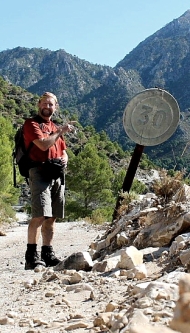










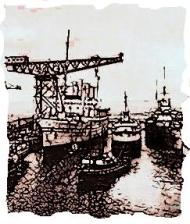
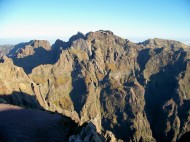
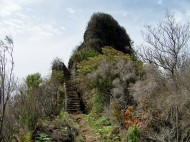





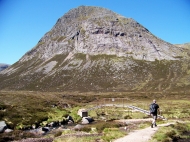


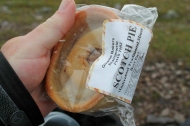
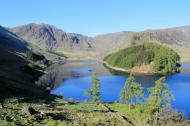




Congratulations on finding the horse whim. I find it’s the present, not history, that “drags at my heels like a wet sack”.
LikeLike
Hi Alastair. Yes, I know what you mean there.
LikeLike
Love it. I might have to go up there sometime….
LikeLike
Hey, great spot for a wild camp, Chrissie.
Cheers, Alen
LikeLike
Funnily enough, that had crossed my mind!????
LikeLike
One to visit, thank you. Fascinating piece and grand photos.
LikeLike
Hi John. Thanks for that. It’s a great area.
Alen
LikeLike
Not entirely unknown. My parents 2 of their friends my husband and I walked that way in 1972 (I’m no good with dates but my husband remembers it well as that is the year we ‘went comprehensive’ a memorable time of our lives!!). Back then the overlords had not made their presence felt and after the first mile or so the track narrowed. We did get to the top but, altho husband is an historian, we didn’t know about horse whims so just saw 2 ‘ruins’ as is par for the course up there. On the way back down Mum and I found an old tin which we scavenged about to fill with ‘Bills Gills Brights’!! That evening we burnt them on the fire but they were much more like slack than Brights!
Thinking about some of your word derivations and usages I wonder if the Wind Egg area off Slei gill is related to winding engines?
Also husband suggests that you might find out more about the Caygills if you check the censuses for 1881,1891 and 1901 but he’s not sure which parish they would come under. But if you found the appropriate parish you might even find the names of earlier miners there.
(As I said in an earlier response to your blog my gr’father was born at Kitley and worked at the New Smelt Mill before moving to Harrogate. My parents bought a cottage in Langthwaite in 1951 which I inherited in 1989 and have just put on the market!!! But over the years we have done a lot of walking in the area.)
LikeLike
Hi Mavis. Thanks for that information ??? I suppose I could call it a real mine of information. I like Bill’s Gills Brights. If I’d had a plastic bag with me I’d have filled it for the stove at home. It looks like the sort of coal that’s ideal for banking up the fire last thing at night and keeping it going till the morning.
I’ve not heard of Wind Egg. That’s a new one on me and I shall look into it.
Caygill seams to be a bit of a local name. I’ve bumped into a few in the area, and of course there’s the famous Arthur Caygill down the road in Richmond with his cycling shop ??? which I visit occasionally. I might have a look through the census returns when I’ve got chance. It can all be done on-line these days so it would be an interesting project.
All the best, Alen
LikeLike
That futility paragraph is so sad but the records don’t show the number of times those men shared a joke or simply enjoyed the view during a quiet moment. i really hope there was more laughter than bullying.
Physics has a formula for finding the depth of holes you’ve dropped a stone into. For the simple version, square the number of seconds then times by five. The hole was a bit deeper than you thought.
LikeLike
Hi Zed. The other side of the coin, as you say, is that they would have had a sense of humour. Having worked in the Cumbrian slate quarrying industry for a few years, I can say from experience that humour always surfaces in the most challenging of conditions. It must have been a bleak and cruel life, though.
Thank you for mentioning the formula because I attempted to work out the depth but got bogged down in all sorts of calculations involving velocity and gravity. In short, I got out of my depth. Forty-five metres sounds about right.
Cheers, Alen
LikeLike
In photo 12 (Lift Shaft Grill With Squatting Man) you look like you’ve just dropped your Fray Bentos down the hole.
I’ve heard Eric Robson say similar things about men and women working in the areas we now ramble over; trudging up Honister Pass etc. And I’ve wondered if our ancestors were fully aware of the hardness of their lives because they would compare their existence to that of their parents and grandparents (not us and our easy lives) and either think ‘nothing is getting any better’ or ‘well it was worse in Great Uncle Obadiah’s day when they were paid with smallpox injections and ate soil.’ As Zed says there would have been lighter moments and thank god there were.
I can’t imagine a subsistence lifestyle, even though the Tories and corporate free market exponents would love to see things go that way. Maybe in 150 years people will look back on us and think ‘imagine living without healthbot clothes and having to breathe every day.’
And on the question of how did all this happen? We failed to have a revolution like the French did. Biggest mistake the British ever made!
Chris
LikeLike
Must agree with every single point you’ve made there, Chris. With the exception of the Fray Bentos pie observation, because I’d be ripping the bars apart like the Incredible Hulk if my pie had slipped between them.
I’m trying to work out whether living standards have improved since when I grew up in the 1960s or we just have more clutter about the house these days which makes it look like they have improved. Industrial injuries and deaths have certainly fallen, thanks to the Health and Safety at Work Act 1974, so I suppose they have. At least we don’t get ice on the inside of our windows these days and curse when the paraffin lamp in the outside loo goes out suddenly.
I stayed up till 5am this morning hoping for a revolution ??? but it never came. We’ll be back to the turf-roof hovels and self-employed labourers claiming New Enterprise Allowance before the year is out.
Al the best, Alen
LikeLike
A few years ago I did a landscape analysis of an area close to where I live. The project involved comparing maps from 1849 onwards and it was during that project that I started to wonder where the hell did all that wealth go; the wealth generated during the industrial revolution.
150 years later and the area was back to square one. Desolate, impoverished, high crime, no social mobility… True, there’s a welfare state (but for how much longer) and an NHS (for how much longer). It looks to me like ‘they’ won. They who have it all and still want more.
Chris
And I sat up ’til 2 am last night watching Britain sleepwalk into its own demise. God knows what’s lying in wait for the next five years.
LikeLike
It???s a sad world. People are swayed by fear. Fear of crime used to be the vote-winner, but this has been replaced by fear of migrants, fear of fiscal incompetence, fear of change, fear of personalities, and ??? outrageously and unashamedly ??? fear of the Scots. I???ve lost count of how many commentators today referred to Scotland as a one-party state. It???s Orwell???s 1984 by the back door.
Perhaps it was the same in the area of your study in 1849, with the authorities ramming the fear of Chartism and the fear of European revolution down people???s necks, and sending them to Australia if they didn???t comply. Perhaps the English (rather than the British) like to be dominated and told what to do because it offers a sort of stability and continuity. Someone should write a book on the subject. I think it???s time for some wine.
LikeLike
That’s a rather special bit of railway rail, Alen, and it might suggest a rather more advanced colliery set-up. It’s wrought-iron fishbelly rail made to John Birkinshaw’s patent of 1820. He invented it at Bedlington Ironworks, using eccentric rolls in the mill to create that bellied shape. The idea was to make the strongest rail for the least weight (=cost) of iron. The supports (chairs) were at the shallow bits where least strength was needed, and the deep bits in the middle were where strength was required. If the bellies are the usual 3ft the whole rail would be 12ft long, but 4ft is not impossible; did you measure it? And you can see the hole in one end for the pin to the joint-chair. The intermediate chairs would be smaller. I wouldn’t expect it to have been made after about 1840, and hardly after 1850 when second-hand steam-railway rail was finding its way to industrial lines. But perhaps that fishbelly rail came second-hand from an early line such as the Stockton & Darlington.
It’s a very fine horse gin you’ve found, and a splendid description. It’s doing no one any harm, and ought to be safe for another century or so. But is it? Is it scheduled &c? It ought to be, and quickly before milords wreck it.
Great things, those Bing aerial pictures: a boon to archaeology and fun for us time-rich uns.
The depth sum is easy. The acceleration of a stone due to gravity here is about 32ft/sec/sec. That means in the first second it falls 32ft, in the second 64ft and in the third 128ft. So if it really took 3 sec to fall, the hole’s about 200ft deep, but only about 100ft if it took 2 sec. I hope you didn’t do what so many do, and counted ‘one’ as you let the stone go! Even so, it’s a deep shaft for what one would expect is a rather marginal colliery. Another hint perhaps, that there’s more to it than meets the eye.
The 1854 6in OS shows a very nice ‘William Gill Colliery’ with a ‘Gin Wheel’ partly(?) inside a covered building (not surprising at 1850ft OD) with two little enclosures to the NW. There’s a square ‘Cinder Oven’ too, meaning the coal was good for coking. The 1891 OS shows it all disused. There’s a track NE down the gill toward the turnpike through a cluster of small, probably shallow coalpits. But there are also a couple of tracks going from the pits toward Punchard Gill and the lead workings there, but not to Gunnerside and Blakethwaite Smelt Mill. No sign of a railway though.
LikeLike
Blimey, Bill. Where do I start? You???ve come up with some fascinating stuff there. I was sort of aware of the antiquity of the rail because I???ve seen old drawings of early railway lines ??? including the Stockton and Darlington ??? but didn???t possess the knowledge to comment on it. I did, though, take a couple of close-ups for situations such as this and have the pleasure of including one here.

Twelve feet sounds about right for the length. I didn???t measure it but it was certainly sticking way above my head (I???m just under 6ft) and there must have been a couple of feet in the ground to give it support. I don???t think there was any railway as such up there, just a couple of short lengths of track to wheel spoil from the pit-head to the tips ??? one striking south-west from the shaft and the other north-east.
The information from the old maps is fascinating. Are they available on-line or would I have to visit a record office to view them? It???s interesting that the 1891 map shows the colliery as disused. There???s a reference on the Durham Mining Museum website to it being classed as abandoned in 1883, but it appears to have reopened again for a few years with records up to 1890. My 1893 figure came from a Northern Mine Research Society reference.
The stone definitely took three seconds to fall because I counted ???one??? as I let it go and it hit the water on the count of ???four???. It wasn???t a big stone, mind ??? about golf ball size. Still, it???s a bloody deep hole.
Thanks for the information, Alen
LikeLike
PS. I don’t think the site is scheduled. My Google searches usually throw up official references to scheduling and that did not happen on this occasion.
LikeLike
PPS. I’ve found the 1854 OS map on-line showing the ring, building and coke oven. The building must have covered the shaft as well. Fascinating stuff. Must return.
LikeLike
Your horse looks a bit frisky to say what a boring job he has!???? Looks an interesting walk though. Imagine if us commoners wanted to put those bulldozed roads everywhere to facilitate our walking routes? Permission certainly would NOT be forthcoming – only the moneyed eh?????
LikeLike
Yes, Carol. There are bulldozed roads all across the Pennines and much of the Highlands, purely for the slaughter of grouse and other birds and animals by the rich. In Victorian times they used to slog up there on foot or horseback. Now they are transported in fleets of gleaaming 4X4s with estate logos painted on the sides. It’s another indicator that the economy is doing well, apparently.
I tried to draw the horse but failed miserably. I found that frisky lad in some clip-art somewhere. He’s called Ringo.
Cheers, Alen
LikeLike
I used to draw horses all the time – I’ll have to put out a post sometime with some of them and my horse-paintings too????
LikeLike
I used to draw trees all the time. They are easier than horses.
LikeLike
I disagree – trees, especially in winter, are far too complicated with all those branches and twigs
LikeLiked by 1 person
Alen, thank you for an interesting post. It is scary how some people slave for their lives in bondage. Was I saying too much? I have often thought about the different and very unequal terms we are born to. Luckily some are able to find new ways in life.
I believe the landscape is fascinating and I like Ringo, the horse, but I would have preferred your own drawing.
People are always extremely amused over my drawings I don’t know why????????
All the best,
Hanna
LikeLike
Hi Hanna. Thanks for your comment. Yes, I believe the landscape is fascinating, and people’s comments have thrown up more facts and made it even more fascinating. What is tragic, though, is that there is still a great deal of inequality in the world ??? even in a supposedly modern and forward-thinking country like England. The divisions between rich and poor are growing wider all the time, and things are only going to get worse.
I like Ringo, too. I might incorporate him into more of my walks.
All the best, Alen
LikeLiked by 1 person
I agree with Zed – I do hope there was happiness in these people’s lives as well as hardship, Alen. Human nature being what it is, I would like to think there was. A great discovery, and especially since you saw it from space! I didn’t know that ‘gin’ was shortened from ‘engine’. Great history – and when I wrenched my eyes from your horse I was alarmed at the massive black hole that had opened up in the ground where the grille had once been. PhotoShop is a pretty much unopened book to me, so well done!
LikeLike
Hi Jo. It’s amazing what you can see from space. Apparently, it’s a myth that the Great Wall of China is the only manmade object that can be seen from space. My horse gin is visible too ??? on a good day anyway.
I thought you’d be impressed by my horse. Following your previous comment on my horse attempts I’ve been studying the works of George Stubbs.
Cheers, Alen
LikeLiked by 1 person
Haha, I can see the improvement. Your horse this time is strangely two-dimensional, but I think you have captured his intense but rather worried expression very well. ????
LikeLiked by 1 person
Hi again Alen,
Have just spent a week in A’dale and gleaned some interesting info re the people who lived up William’s Gill. There was quite a thriving community many of whom were Methodists as round about the mid 1800s they were on the circuit plan, had a preacher every Sunday and classes were held too. Living there, again in mid 1800s, was a certain Hannah Raynor who was a school teacher and who ran a small school thus ‘keeping up standards’ as far as poss for the locals. My informants felt that though life would have been hard for the community there, they would have had access to the same commodities as other settlements lower down the dale and generally would have been no worse off. In those days they would not have been as isolated as the location would make one think.
LikeLike
Hi Mavis. Thanks for that. It’s fascinating stuff. So there was a thriving community at one time and some basic comforts and culture. To walk up there nowadays it’s hard to believe there was once a community, because there’s scarce a stone left standing except at the colliery. One of the old maps I’ve seen refers to “William Gill Houses”, just below the mine, but there is very little to see on the ground. I might have another walk up there soon and another poke about. It’s an interesting place.
Thanks again, Alen
LikeLike
Hi there, what a great article. I am very interested in William Gill as my Great Grandfather William Preston was born there and worked in the mine with his father, my Great Great Grandfather Preston who was married to one f William Caygills daughters. Both Williams and family moved down to Whaw between 1861 and 1871 and worked at Great Punchard and some Lead Mining also. You can see tall this on the 1841 census onwards. William Snr married Mary Caygill in 1831 at Gretna Green – nothing is new in theses modern times !!! If you want anymore help on the census let me know.
Finally a picture of William Preston Jnr in his elder days in, I think his back yard of his Whaw cottage.
Sorry it won’t copy in – send me an email address and I will forward it.
LikeLike
Hiya Graham. That’s a fascinating insight ??? the human side of an otherwise bleak story.
If you want to send the picture to [email protected] I’ll pop it on the bottom of the article with an explanation and credit.
All the best, Alen
LikeLike
I have to say im not a purist when it comes to the shooting tracks. If it helps to keep me dryshod as I wander the moors then fine by me.
LikeLike